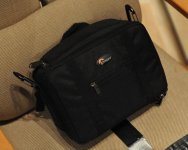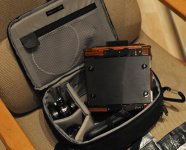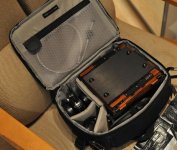Handheld 4x5 work
Handheld 4x5 work
Crown and Speed Graphics with beautiful 127 Ektar lenses were almost all we used, my first 7 years as a school photographer. We covered everything from product shots to portraits to sports with them, and it occurs that I should share some of our technique.
We almost always shot with Stroboflash IV units, which gave a good exposure at about 15'-20' at about f/16-f/22 for sports-type action.
For moving targets---US football or basketball or whatever---we set the camera at f/16, hoped the action came toward us, and pushed the shutter solenoid battery pack button when it was about 15' away. There was no rangefinder focusing on moving targets; we either used the wire frame finder (in the second notch from the top for parallax correction at that distance) or sometimes the optical viewfinder if that camera had a good one.
This obviously required skills such as correct anticipation of where the action would happen, to be in position and ready.
We carried about 10 holders for 20 shots, and would run them to the darkroom and change film at half time of a football game, then shoot however many during the second half.
For lighting large areas, such as the front of a building or football stadium at night, we often used big magnesium foil filled flashbulbs, many of which were WWII surplus from night aerial reconnaissance! Space 3 or 4 of us connected by wires, or just with the big bulbs on a flash gun, in front of a grandstand, and the trusty Graphic on a tripod, and when the main flash went off, the helpers would set theirs off. A 1-second exposure was plenty long enough for everybody to set off their flash and those babies put out enough lumens to shoot EI 400 film at f/11 or f/16, even at that distance.
When all you worked with was a Crown or Speed Graphic, the flow was efficient and images could be stunning.
The last models of Graphics had much-improved integral rangefinders; the ubiquitous Kalart ones usually mounted on the side of the cameas were so dim that we preferred using the ground glass whenever possible. The later ones had a flashlight bulb inside the rangefinder that occasionally worked; you could turn it on, the light beam would be projected out the rangefinder ports, and if the surroundings were dim enough, you could focus the two dots of lights together on your subject and know that would be sharp.
I gave a friend my last Crown Graphic, then sold my Super Graphic I had modified to give more-than-adequate field camera movements back in the early 90s. Soooo...of course I had to find another one for which I have a range of excellent lenses, and it's all the 4x5 camera I'll ever need.
It doesn't matter which camera you have, the thing that is most changeable and adaptable is your eye and perception, and that's what makes a real difference, not worrying about whether another piece of gear will make you the fad of the forum. Study great paintings, read fine literature, watch the way great movie directors light scenes, LOOK at light all the time. That will make really meaningful improvements in your photography.




